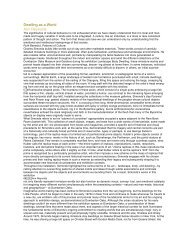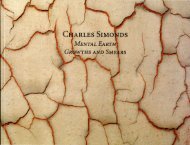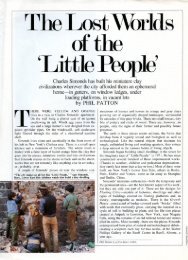Read Catalog - Charles Simonds
Read Catalog - Charles Simonds
Read Catalog - Charles Simonds
You also want an ePaper? Increase the reach of your titles
YUMPU automatically turns print PDFs into web optimized ePapers that Google loves.
This return to the beginning, this participation in the vital principle, <strong>Simonds</strong><br />
made the subject of his first film, Birth. From the uniformity of the clayey<br />
earth he slowly emerges, nude and still covered with the original slime, as at<br />
the moment of the creation of the world. Beginning with this symbolic rebirth,<br />
culture and experience coincide in a totally ritualized universe.<br />
It was in order to obey the implicit dictates of the clay that <strong>Simonds</strong>'s first<br />
constructions were of ritual places. He strove to transfer his intimate knowledge<br />
of the material to them; to make himself, in miniaturizing them, both<br />
their creator and witness. This remote possession is in fact identical to that<br />
obtained by the witch doctor from his doll: it tends to confer upon one who<br />
at first is a submissive participant, the powers of a high priest. Thus it is not<br />
without reason that <strong>Simonds</strong> has naturally reproduced the successive periods<br />
of Genesis: life created from dust, the peopling of a formerly deserted world<br />
-and this to the very point of creating a miniature cosmogony. Man forms<br />
the link between the infinitely great and the infinitely small, between the<br />
universe that surpasses him and that he masters.<br />
In more general terms, the art of the 1970s favored this turning to the miniscule,<br />
to the invisible, as if, after the spectacular demonstrations of color-field<br />
painting and Pop Art, it was appropriate to abandon retinal evidence in favor<br />
of mental acuity, surface for gravity. The defiance of art and its values, a<br />
constant for most 2oth-century creators, is no longer foreign to this reduction<br />
that offers the lowest profile and partially avoids for its creator the label of<br />
artist. The films, the photographic works, the ephemeral nature of the Dwellings,<br />
the realizations in the street, spring from the same ethic-what <strong>Simonds</strong><br />
is dealing with is less the nature of art than its social role. Moreover, this latter<br />
concern may seem in the early work to be the essential point of his quest.<br />
<strong>Simonds</strong> was not satisfied with working randomly in the streets. Quickly he<br />
concentrated his work in a section of the Lower East Side of Manhattan, bit<br />
by bit integrating himself with this community, responding to an unformulated<br />
expectation, playing the part of a catalyst rather than an artist. Thus,<br />
in the development of the Placita playlot (pl. 25), his contribution is scarcely<br />
visually recognizable: it is to be found in the very existence of the project and<br />
in the energy necessary to bring it to its conclusion. One might think that his<br />
work in the streets, parallel to the development of the sculptures, is in some<br />
way alien to them. Yet they are one, for the street works enabled the sculptures<br />
to take a new dimension, a mythological amplitude.<br />
<strong>Simonds</strong> has stressed how from the moment his work was carried into the<br />
street the heroic achievement of the Little People was born:<br />
At this period (1970) there were, in fact, two different peoples who were at<br />
war: the inhabitants of the cliffs, hunters, who lived in the walls and projections<br />
of the buildings, and the shepherds who lived on the plain of the<br />
streets, in the gutters and against the foundations of the buildings. The<br />
cliff dwellers regularly came down to raid the plains dwellers. Finally conquests<br />
and assimilation united the two peoples. 3<br />
The street served as an echo chamber to the summary buildings which at that<br />
time <strong>Simonds</strong> strewed among the jagged outlines of the city walls. There were<br />
the comments of the passersby, the neighborhood children, who helped formulate<br />
the true mythology of the Little People. The spectators formulated,<br />
in a collective projection, the chronicle of this people, explained their cus-<br />
32












